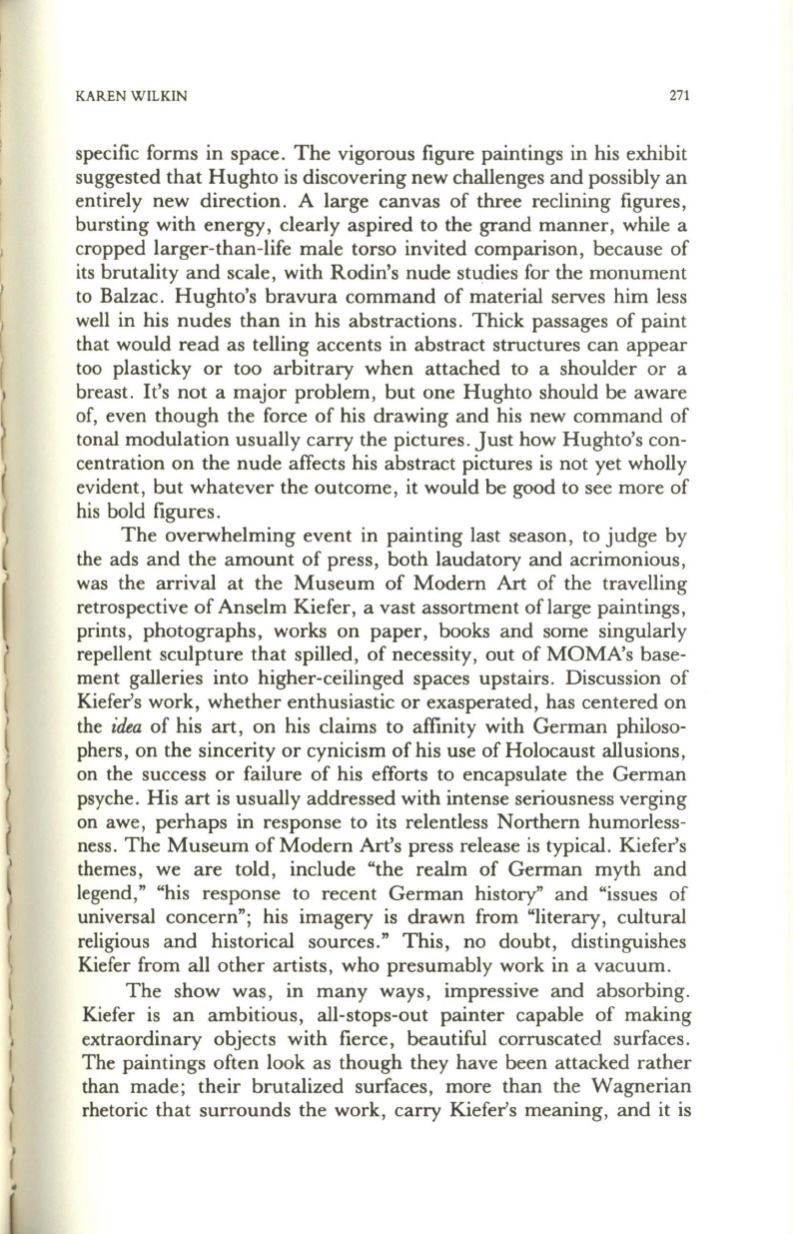
r
I
!
)
KAREN WILKIN
271
specific forms in space. The vigorous figure paintings in his exhibit
suggested that Hughto is discovering new challenges and possibly an
entirely new direction. A large canvas of three reclining figures,
bursting with energy, clearly aspired to the grand manner, while a
cropped larger-than-life male torso invited comparison, because of
its brutality and scale, with Rodin's nude studies for the monument
to Balzac. Hughto's bravura command of material serves him less
well in his nudes than in his abstractions. Thick passages of paint
that would read as telling accents in abstract structures can appear
too plasticky or too arbitrary when attached to a shoulder or a
breast. It's not a major problem, but one Hughto should be aware
of, even though the force of his drawing and his new command of
tonal modulation usually carry the pictures . Just how Hughto's con–
centration on the nude affects his abstract pictures is not yet wholly
evident, but whatever the outcome, it would be good to see more of
his bold figures.
The overwhelming event in painting last season, to judge by
the ads and the amount of press, both laudatory and acrimonious,
was the arrival at the Museum of Modern
Art
of the travelling
retrospective of Anselm Kiefer, a vast assortment oflarge paintings,
prints, photographs, works on paper, books and some singularly
repellent sculpture that spilled, of necessity, out of MOMA's base–
ment galleries into higher-ceilinged spaces upstairs. Discussion of
Kiefer's work, whether enthusiastic or exasperated, has centered on
the
idea
of his art, on his claims to affinity with German philoso–
phers, on the sincerity or cynicism of his use of Holocaust allusions,
on the success or failure of his efforts to encapsulate the German
psyche. His art is usually addressed with intense seriousness verging
on awe, perhaps in response to its relentless Northern humorless–
ness. The Museum of Modern Art's press release is typical. Kiefer's
themes, we are told, include "the realm of German myth and
legend," "his response to recent German history" and "issues of
universal concern"; his imagery is drawn from "literary, cultural
religious and historical sources." This, no doubt, distinguishes
Kiefer from all other artists, who presumably work in a vacuum.
The show was, in many ways, impressive and absorbing.
Kiefer is an ambitious, all-stops-out painter capable of making
extraordinary objects with fierce, beautiful corruscated surfaces.
The paintings often look as though they have been attacked rather
than made; their brutalized surfaces, more than the Wagnerian
rhetoric that surrounds the work, carry Kiefer's meaning, and it is


